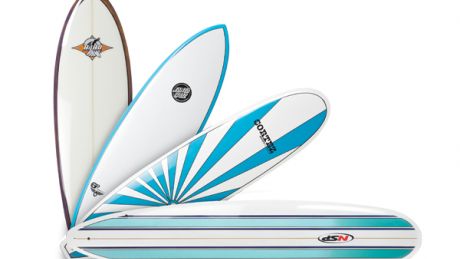Surfboard buyer's guide
If you're planning to pick up your first board or get a new one to replace your battered ride, you need to read our surfboard buyer's guide.

Foam boards
When you take your first lesson with a surf school, this is what they'll normally give you to ride. This is because foam boards are hard-wearing, soft enough that you can fall on them without hurting yourself and incredibly buoyant, meaning you can catch small, weak waves on them. Foam boards are also cheaper than hard boards so it might be worth picking one up if you want to try surfing for the first time but don't want to break the bank when buying kit.
Longboards
Once you've got comfortable with a foam board, it's time to move on to one of these hard boards, which are made of polyurethane or polystyrene foam covered with layers of fibreglass, cloth and polyester or epoxy resin. Also called a 'Mal' (short for Malibu, one of the most popular longboard waves in the world), longboards can be between 2.5m and 4m long and typically have a single fin and a large round nose. Due to their considerable surface area, a board of this size will still be very buoyant and easy to catch waves on.
Mini Mals
Mini Mals, which are basically shorter longboards, typically range in size from 2m to 2.5m. They're more manoeuvrable than longboards due to their shorter length and are often ridden by smaller people who want a longboard-style ride but aren't big enough to control the bigger boards.
Shortboards
Shortboards tend to be between 1.5m to 2m long and provide great manoeuvrability on the wave. But owing to their smaller surface area and decreased buoyancy, you need larger, steeper waves to ride them. They usually have a pointed nose, a round or square tail and often use three fins to help you make more dynamic turns on the water.
Stand-up paddle boards
A stand-up paddle set-up comprises a longboard between 3m and 4m and a paddle. Rather than lying down on the board and paddling on to a wave with your arms, you stand on it and use the paddle to propel yourself forward. These can be used in a huge range of conditions – from when the surf is too massive to hand-paddle into to when it's totally flat.
Accessories you need to know about
Wax
Wax helps your feet grip the top of the board. Harder wax is used in cold water, softer wax in warmer water.
Fins
Fins help to stabilise your board and stop it from sliding sideways on the wave. Removable fin systems allow you to change your set-up depending on the waves your surfing and style of riding you're attempting.
Leashes
A leash attaches you to the end of your board so you don't lose it when a wave knocks you off. They normally comprise a urethane cord with a padded ankle strap and Velcro fastening.
Grip pads
Grip pads are used by many surfers for additional back foot traction.
Surfdome stocks a huge selection of surf gear, including boards, wetsuits and clothing. Go to surfdome.com to find the the right kit for you.
For surf-ready workouts and technique tips, subscribe to Men's Fitness and you'll get five issues for just £5. You can also download digital versions of the mag here.
Sign up for workout ideas, training advice, reviews of the latest gear and more.
